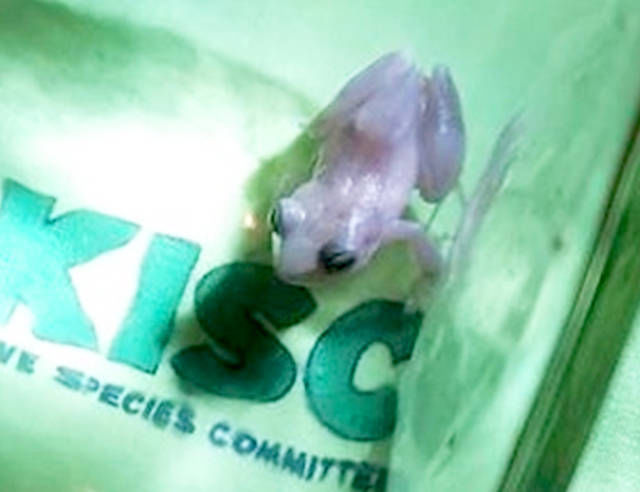LIHUE — A little problem with loud consequences was captured at a Lihue residence Monday, most likely a stowaway in a car recently bought from Hawaii Island. The male coqui frog was heard chirping by a neighbor, according to the
LIHUE — A little problem with loud consequences was captured at a Lihue residence Monday, most likely a stowaway in a car recently bought from Hawaii Island.
The male coqui frog was heard chirping by a neighbor, according to the Hawaii Department of Agriculture after the resident bought a car from the Big Island. The frog was contained and eliminated by crews from HDOA and the Kauai Invasive Species Committee. Surveillance of the area will continue.
“This capture is a great example of the Kauai community working together to prevent invasive pests from establishing on our island,” said Tiffani Keanini, of KISC.
The noise is the problem with coqui frogs, which are about the size of a quarter. The males emit a chirp, and the species multiplies rapidly.
Their numbers can reach into the tens of thousands and they make noise all night long, according to Pam Varma, who lives in the Wailua Houselots. She just returned from a trip to Hilo on the Big Island, where she experienced firsthand how loud the frogs can be.
“It’s a cute sound, actually somewhat pleasant with just a few, but when you hear 40,000, it’s a solid wall of sound,” she said. “Even if you’re driving with your windows up, you can hear them.”
As a visitor, it was a quirk she was willing to put up with during her stay in Hilo, but she said she’d find the sound less amusing if she had to live with it.
Those that live there say it has definitely changed the atmosphere of the nights on the Big Island.
“In areas where they are widespread, it’s a constant sound from dusk to dawn and even past that,” said Franny Brewer, communications director with the Big Island Invasive Species Committee.
And over the past 15 years the frogs have expanded their nightly chirping to an occasional chorus during an overcast day.
“They’re getting more bold and we’ve actually noticed that they’re getting bigger,” Brewer said. “One theory is that they’re living longer than they did in their native environment and they don’t have much predation.”
She said some people have found coqui frogs that are three times the size they were 15 years ago.
While Varma said it’s the “wall of sound” that can get overwhelming, Brewer said the chirping of thousands of frogs becomes “white noise” in her own experience and that of her friends.
“It’s when there’s just one or two and every single chirp breaks the silence that’s the worst,” she said. “Most of us get used to it when it’s a whole bunch of them.”
Eradicating the coqui frog is nearly impossible, Brewer said, especially in areas where they are infested because mitigation measures include things like hand capture and the use of citric acid.
There is one species that’s been found to impact the coqui frog population on the Big Island, she said, and that’s little fire ants.
“The frog populations have declined in places were there are little fire ant infestations, but property owners say they’d rather have the frogs,” she said.
The frogs tend to do some island hopping from time to time, and Monday’s discovery isn’t the first time a coqui frog made it to the Garden Island.
Three years ago, Varma heard one down the street from her house after she’d returned from a trip to the Big Island.
“I was sitting in my office at my house at about 9 at night and I heard a coqui out the window,” she said. “So my boyfriend and I followed the sound down the street. The frog was two houses down in their front yard foliage.”
She called KISC and reported the frog immediately.
“Later they told me they could hear the frog in the background of the voicemail, so they knew it was real,” she said.
It took two trips for KISC staff members to trap the juvenile male frog.
“They’re so small and they can come into Kauai in so many different ways,” Varma said. “It could get into your camping gear, and through potted plants.”
Plants are one of the major coqui frog transporters, Keanini said, especially in the spring as people begin to garden.
“Coqui frogs have no tadpole stage, allowing them to easily hitchhike in shipments from infested areas on neighbor islands,” Keanini said. “As people begin to garden this spring, this capture serves as an important reminder that we need to inspect and survey plant materials from off-island.”
Keanini and Varma both recommend immediately reporting any coqui frog sounds or sightings to KISC at 821-1490 in order to start containment efforts as quickly as possible
“Here on Kauai, we’ve got the roosters, but they stop in between crows. With frogs, there’s no break and it’s intense,” Varma said. “The frogs would really change the complexion of Kauai and we want to keep Kauai quiet.”


